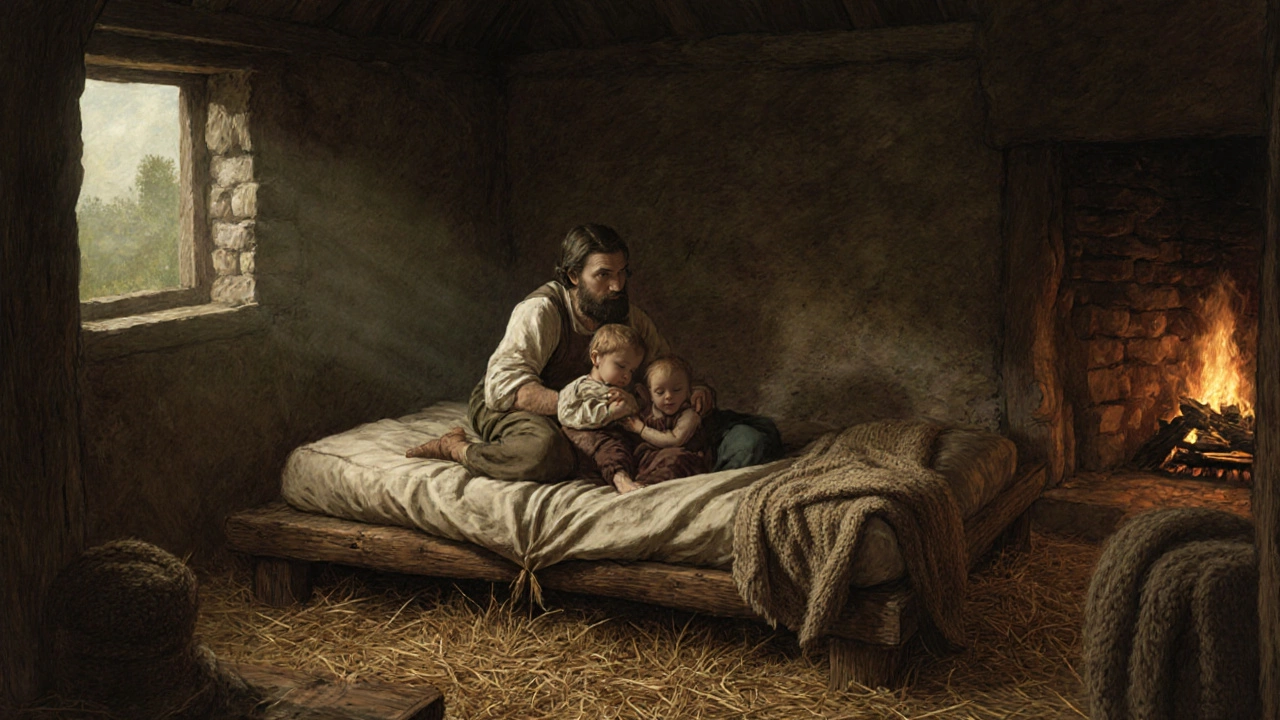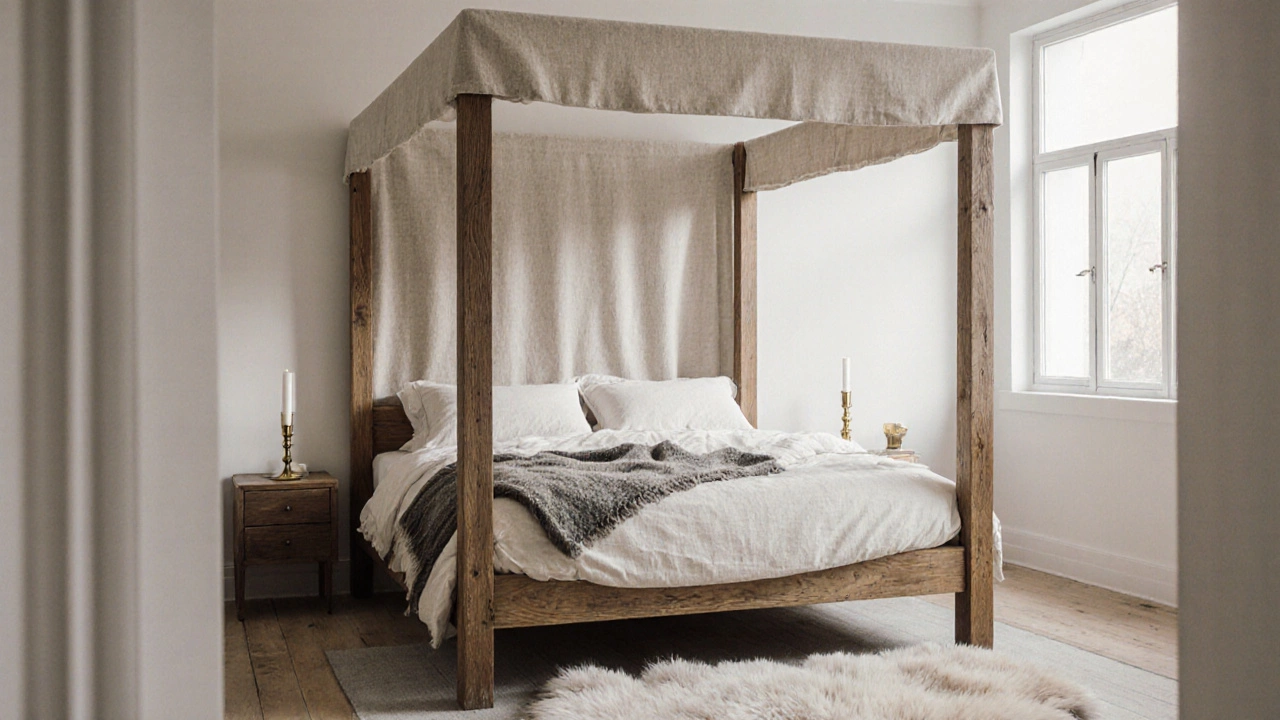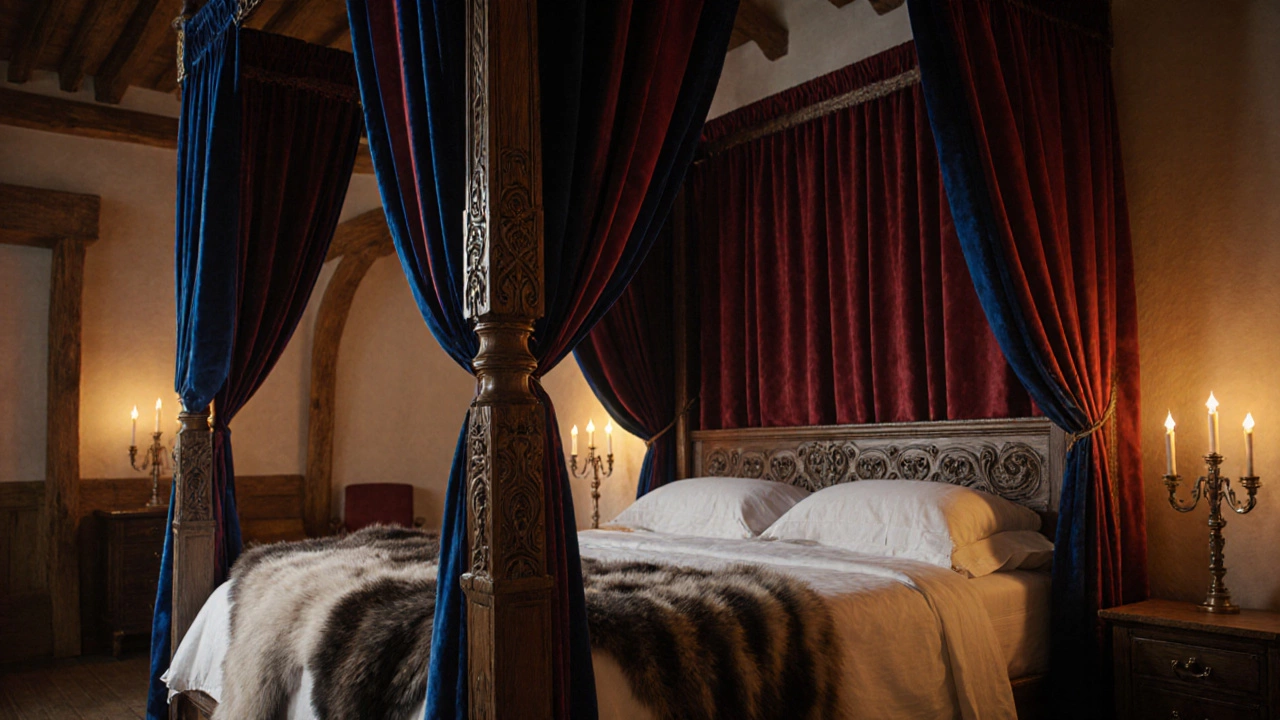Medieval Bedding Social Status Checker
Discover what kind of bedding you would have had in medieval Europe based on your social status. Select your status to see the differences between peasant, middle-class, and noble bedding.
Peasant Bedding
The most common bedding used by the majority of the medieval population. Simple, practical, and affordable.
Core Components
Frame: Simple oak or pine frame
Mattress: Straw or hay sack (replaced every few months)
Sheets: Undyed linen (if available)
Blankets: Single layer wool blanket
Canopy: Rare, usually none
Location: Near hearth, often shared by family
Key Characteristics
When you picture a medieval bedroom, you might imagine towering canopies, heavy drapes, and a stack of blankets piled on a wooden frame. Medieval bedding is a collection of sleep surfaces, coverings, and accessories used in Europe from the 5th to the 15th century. It varied wildly between a lord’s hall and a peasant’s cottage, and its components tell a lot about material culture, trade routes, and daily life.
Core Components of Medieval Bedding
Even the simplest medieval bed shared three basic parts: a frame, a sleeping surface, and coverings. Each part could be built from locally sourced resources or imported luxuries.
- Wooden frame - typically oak or pine, nailed together without glue.
- Mattress - a sack filled with straw, hay, feathers, wool, or a mix.
- Coverings - linen sheets, woolen blankets, and sometimes fur pelts.
The exact combination depended on wealth, climate, and local tradition.
Straw and Hay Mattresses: The Peasant Standard
For the majority of Europe’s population, a mattress was a simple straw mattress. Freshly cut straw was packed into a canvas sack, tied shut, and laid directly on the frame. It was cheap, breathable, and could be rotated to extend its life. However, straw compressed quickly, so bedding had to be refreshed every few months.
Hay-coarser and more readily available-served the same purpose in colder regions. Both materials acted as a modest cushion and, importantly, as insulation from damp ground.
Featherbeds: Luxury for the Upper Classes
Featherbeds arrived in Europe through the Crusades and later the Hanseatic trade. A featherbed consisted of a large canvas bag filled with down or feathers from geese and ducks. The result was a soft, springy surface that stayed warm even in winter.
Featherbeds were expensive to purchase and maintain; feathers needed regular fluffing, and the bags required occasional rewinding. Consequently, only nobility or wealthy merchants could afford them.
Linen Sheets and Woolen Blankets
Linen sheets were the common under‑layer. Linen, made from flax, was prized for its durability and breathability. In the 13th century, a full set of linen (sheet, pillowcase, and sometimes a night‑shirt) could cost a fourth of a laborer’s annual wages.
Above the sheets, sleepers added wool blankets. Wool, sourced from sheep or goats, provided essential warmth. Wealthier households layered multiple blankets or added a fur pellet for extra insulation. Fur, especially from rabbit or beaver, was a status symbol and often displayed in the bedroom as décor.

Canopies and Four‑Poster Beds: Symbolism and Function
While simple wooden frames sufficed for most, aristocratic chambers featured elaborate structures. The four‑poster bed-four vertical posts connected by a canopy-served both practical and symbolic roles.
Practically, the canopy supported heavy curtains that shielded sleepers from drafts and insects. Symbolically, the towering posts declared wealth; the more elaborate the carvings, the higher the owner’s social rank.
Canopies were often lined with velvet or silk, and the curtains could be dyed deep reds or blues-colors that only the upper class could afford due to expensive dyeing processes using cochineal or indigo.
Regional Variations Across Europe
Geography shaped bedding choices. In the damp climate of England, woolen blankets were thick, and peat‑heated rooms complemented bed placement near the fire. In the Mediterranean, light linen sheets and thin wool blankets sufficed, and beds were sometimes placed near open courtyards for cooler nights.
Trade routes introduced exotic materials. Venetian merchants brought silk curtains to northern courts, while the Baltic trade supplied high‑quality linen to Danish nobles. These regional differences highlight how medieval bedding was a blend of local resources and far‑reaching commerce.
Comparison: Noble vs. Peasant Bedding
| Aspect | Peasant | Noble |
|---|---|---|
| Frame material | Simple oak or pine | Carved oak with metal brackets |
| Mattress fill | Straw or hay | Feather or down |
| Sheets | Undyed linen | Finely woven, often dyed linen or silk |
| Blankets | Wool, single layer | Multiple wool layers, fur pelts |
| Canopy | Rare, usually none | Four‑poster with heavy drapes |
| Location in home | Near hearth, often shared | Separate chamber, positioned away from fire |
Everyday Life: How Medieval People Used Their Bedding
Sleep was not a private affair for most. In peasant households, the entire family often slept on a single straw mattress, stacking younger children on top. The bed served as a daytime resting spot, a place for storytelling, and sometimes a storage area for clothing.
Nobles, on the other hand, used the bed as a stage for social rituals. Guests were received in the bedchamber, and marriages were formalized on the four‑poster. The bed’s size and décor communicated power; a larger canopy meant the owner could host more influential guests.
Both classes relied on the nightly ritual of airing bedding. Windows were opened, and blankets were shaken out to keep moths at bay. In colder months, a morning fire would be lit, and the bed warmed before climbing in.

Preserving Medieval Bedding: What Archaeologists Find
When excavations uncover a medieval site, bedding rarely survives intact because organic materials decompose. However, archaeologists can identify bedding through indirect evidence: postholes indicating a bed frame, iron nails, or stains on floor tiles that suggest a mattress was once present.
In some well‑preserved sites-like monastic cloisters-waterlogged conditions have kept straw and wool intact, allowing researchers to reconstruct exact mattress dimensions. Textile analysis of surviving linen fragments reveals weaving patterns, confirming historical records that luxury linens were tightly woven and dyed using costly pigments.
Modern Takeaways: What Today’s Home Decor Can Learn
Understanding medieval bedding offers fresh ideas for contemporary interiors. The contrast between simple straw mattresses and opulent featherbeds illustrates how texture can define a room’s mood. Re‑creating a four‑poster canopy with modern fabrics can bring a sense of drama without breaking the bank.
Even the humble practice of rotating a mattress can improve longevity-something medieval peasants did out of necessity. Using natural fibers like linen and wool not only feels authentic but also boosts breathability, a lesson centuries old.
Quick Checklist for a Medieval‑Inspired Bedroom
- Choose a sturdy wooden frame; reclaimed oak adds authenticity.
- Layer a firm mattress-consider a modern latex core topped with a straw‑style pillow for texture.
- Dress the bed in natural linen sheets; add a wool blanket for warmth.
- If space allows, install a simple canopy using linen curtains hung from four posts.
- Place a fur‑like throw or faux‑furs at the foot for a touch of luxury.
- Keep a small candle or lantern on a bedside table to echo medieval lighting.
Frequently Asked Questions
What materials were most common for medieval mattress fills?
The majority of beds used straw or hay because they were cheap and widely available. Wealthier households could afford feather or down fillings, which provided a softer, warmer surface.
Did medieval people sleep on pillows?
Pillows existed but were rare for peasants. They were usually stuffed with feathers or herbs and reserved for the upper classes. Most people rested directly on their mattress or used a small head cushion made of cloth.
How were beds kept clean in medieval times?
Cleaning was mainly a matter of airing out the bedding. Blankets were taken outside to be shaken and sun‑dried. Linen sheets were washed in river water with lye. The mattress itself was replaced or refreshed every few months.
Were canopies purely decorative?
Canopies served both decorative and practical purposes. Heavy curtains blocked drafts, kept insects out, and added an extra layer of insulation, while the ornate design displayed wealth.
What evidence do we have of medieval bedding?
Archaeologists rely on postholes, iron nails, and stains indicating mattress placement. In rare water‑logged sites, actual straw, wool, and linen fragments survive, allowing detailed reconstruction of bedding structures.

